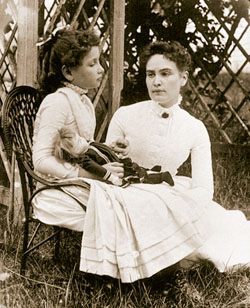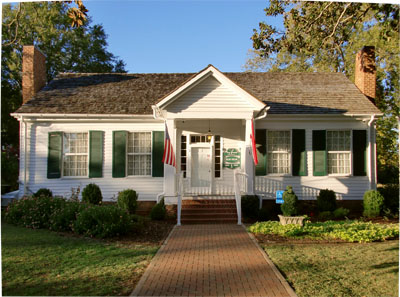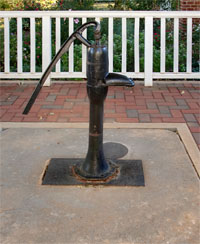Christian Living Stories: The Miracle Workers
My favorite movie of all time is The Miracle Worker, the story of blind, deaf Helen Keller and her teacher, Annie Sullivan, whose love and patience taught Helen to read and speak. My favorite scene is the moment at the well where Helen suddenly grasps the link between symbols and objects. Today I was able to visit the place where the miracle happened.
 |
| Helen Keller with Anne Sullivan in 1888 |
Helen Keller was born in this quiet northern Alabama town. When she was 18 months old, she suffered an illness that left her blind and deaf. She grew up in a world of total darkness and silence. The little girl was intelligent, but unable to communicate or respond in any meaningful way.
Eventually her desperate parents hired a teacher and governess, Annie Sullivan. Annie took up the challenge of trying to reach through to the half-wild little girl. Helen would seem to enjoy it as Annie would allow her to feel objects, then, using a special finger alphabet, spell out the name of the object into her hand. But it was an exercise in frustration and futility. Helen could not make the connection.
Then one day the miracle happened. Helen tells it in her own words in her autobiography, The Story of My Life:
“We walked down the path to the well-house, attracted by the fragrance of the honeysuckle with which it was covered. Someone was drawing water and my teacher placed my hand under the spout. As the cool stream gushed over one hand, she spelled into the other the word water, first slowly and then rapidly. I stood still, my whole attention fixed upon the motions of her fingers.
“Suddenly I felt a misty consciousness as of something forgotten—a thrill of returning thought; and somehow the mystery of language was revealed to me. I knew then that “w-a-t-e-r” meant the wonderful cool something that was flowing over my hand. That living word awakened my soul, gave it light, hope, joy and set it free!”
Helen’s dark and silent world suddenly exploded into a new life. She learned 30 new words that day, and then in the next few weeks hundreds more. Helen went on to graduate with honors from Radcliffe College, and until she died in 1968, traveled the world as source of hope and inspiration to all she met. It all began that day at the well with a dedicated and loving teacher who loved her and believed in her potential.
Helen Keller’s home has been preserved. The well pump is still there, although it is now covered with a protective roof instead of honeysuckle. Standing by the pump I tried to imagine the feeling of freedom and joy Helen experienced when she suddenly grasped language and her life was transformed. And it occurred to me that I, and probably you, have had a similar experience.
The hour I first believed
I can vividly recall the time and place when I first really understood that Jesus loves me, redeemed me and will never leave me. I had heard he was my Savior all my life, but it was just another religious cliché. I was born into a Protestant family, and we later became Catholic, but when I was in my teens I abandoned it all. I became interested in Christianity again when I was 20, and was rebaptized. But looking back I realize that, even though I was sincere, I still had not really understood what it meant. Then one day, after working late, as I was praying in the photographic darkroom of the print shop where I worked, it hit me. Like Helen, I suddenly saw the connection between the symbol and the reality. Why then? Why there? I don’t know.
I suspect that many people reading this can also remember a similar moment when it “came together,” and we suddenly knew we had a Savior. For the apostle Paul, it was on the road to Damascus. For “Doubting Thomas” it was a face-to-face encounter with Jesus after Jesus was resurrected. For the thief on the cross it was the agonizing moments before death. For me it was while praying in a darkroom. For you…?
As my understanding of Christianity has developed, I have come to appreciate that Jesus is not only my Savior but the Savior of all humankind. He came to bring the sights and sounds of salvation to a spiritually blind and deaf world. He said, “And I, when I am lifted up from the earth, will draw all people to myself” (John 12:32).
 | |
| The house where Helen Keller grew up | |
 |  |
| Helen Keller in 1904 | The water pump where Helen first discovered the miracle of language. |
All people! Our triune God—Father, Son and Spirit—is one God who dwells in an eternal communion of love, and he has passed on that connectedness to the whole creation, and most especially to us humans. More than that, the Son of God actually became one of us, permanently identifying with us and sharing with us his own perfect relationship of love with the Father. “For God was pleased to have all his fullness dwell in him, and through him to reconcile all things to himself…” Paul wrote in Colossians 1:19-20.
Jesus isn’t trying to reconcile the world to God; he’s already done it. This surely affects how we look at our fellow human beings. They’re not outsiders; they’re insiders who don’t know it yet, brothers and sisters whom he is drawing to himself just as he said he would.
We religious people are very good at pigeonholing others. “Saved and unsaved,” “righteous and unrighteous,” “insiders and outsiders,” and even “our church” and “their church.” But the truth is, we are all in the same boat—lost, blind and deaf until the Son of God took up our cause and “the Light shines in the darkness, but the darkness has not understood it” (John 1:5).
Every human is somewhere along that path of being drawn home to Christ. Some of us, thank God, have already had our eyes and ears opened, and Jesus wants us not to sit in judgment of those still on the path, but rather to share in his work of bringing them home too.
Annie Sullivan yearned to bring the light of human contact, communication and friendship into Helen Keller’s darkness. She could not force her mind open. But by months of persistent, unconditional love she built a relationship of trust and became the agent though which the miracle could happen.
Helen Keller was a devout Christian. Later in life, looking back on her years of silence and darkness, she wrote, “I always knew [God] was there. I just did not know his name.”
Like Helen, I suddenly saw the connection between the symbol and the reality. Why then? Why there? I don’t know.
For many people, the connection between life and Jesus has not yet dawned. But God is both patient and relentless in his undying love. He never forces anyone to receive it, for then it would not be love, but he won’t give up on even the most stubborn holdouts because even they belong to Jesus.
God has given us, those who already believe, the blessing of joining him in our small way in his ongoing work of making his good news known. Sometimes it might seem we aren’t getting anywhere. That is why we need to encourage, support and inspire one another—and along the way learn something about what it means to live together in Christ in loving communion.
After all, God created us to stick together in love—to love one another just as Christ loves us and gave himself for us. By that love, Jesus said, others will know that we belong to him (John 13:35). God’s gift of faith and salvation is a miracle—a miracle he wants us first to receive and then to live and tell others about.
Just as the water from the pump triggered a new life for Helen Keller, so the water of the Word triggers a new life for all who receive it.
Author: John Halford
